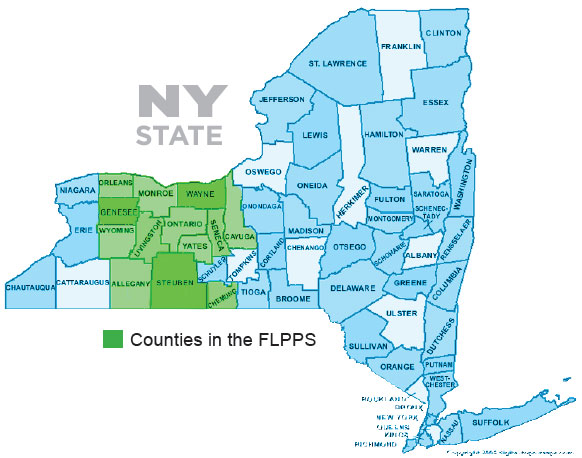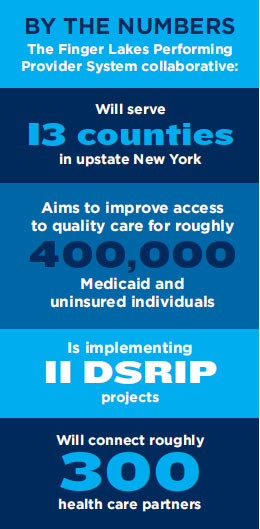Healthcare providers in upstate New York are looking to transform care specifically for the Medicaid and uninsured population. Currently, the region is plagued by the same challenges facing many communities nationwide. Namely, a health care delivery system that operates in silos with poor care transitions and a disconnected information technology infrastructure that limits the ability to identify at-risk patients and track patients across the care continuum.
The newly formed Finger Lakes Performing Provider System (FLPPS) Corporation in Rochester, New York, aims to change that. It plans to build an integrated health care delivery system where providers and caregivers are working together to deliver care in a systematic, unsiloed way so it’s easier for patients to access and understand their care across the continuum. The FLPPS—an ACO-like entity—submitted its Delivery System Reform Incentive Payment (DSRIP) Project application to the New York Department of Health in December 2014.
DSRIP programs, which started in 2011 in California and have been implemented in a number states as part of the Medicaid 1115 Demonstration Waivers, are overseen by the Centers for Medicare & Medicaid Services and operated by State Health Departments or Commissions. The foundation of the program is incentive-based payments to encourage providers to change culture and operational practices that will be necessary to have financial success in a future capitated, population-health-based payment world. The FLPPS will implement 11 DSRIP projects (with implementation plans due June 2015) over a five-year period. The DSRIP projects are aimed at improving access to quality care for roughly 400,000 Medicaid and uninsured individuals by working with roughly 300 health care partners to fully integrate care, develop infrastructure to track and manage population health, and pilot new models of care in the community.

The Finger Lakes collaborative has a lot of heavy lifting to do to realize its goals. The FLPPS has a service area of 13 counties in upstate New York. It’s the largest, most geographically diverse PPS in New York State with a mix of urban and rural populations. Roughly one-third of the region’s population lives in a Primary Care Health Professional Shortage Area. In addition, patients are under-using primary care providers, which has led to poor health outcomes and inappropriate utilization of services. Historically, there has also been a lack of coordination between providers—especially primary care and behavioral health. Add to that the technological burden of building a health information exchange (HIE) to connect all of these providers and caregivers. The FLPPS HIE committee is currently examining what technology systems providers have or don’t have in place because technology will be a critical factor in the success of this initiative. The HIE needs to be robust enough to enable information flow between systems, so providers can get the information they need in a timely manner.
Inside the Collaborative
The University of Rochester Medical Center, an academic medical center with a 830-bed teaching and research hospital, children’s hospital, and two community hospitals, partnered with Rochester Regional Health System, which has five acute care hospitals and more than 80 medical practices, to lead the way as the parent organizations for the collaborative. The FLPPS also includes primary care, specialty care and behavioral health physicians, skilled nursing facilities, long-term care facilities, local agencies such as county public health and mental health departments, and community-based organizations such as housing authorities and transportation agencies.
The Finger Lakes collaborative is implementing 11 DSRIP projects that are tied to the needs of the population in their region. They are:
-
- Integrated delivery system project (IDS). This is the overarching project across several treatment modalities and provider types. Creating an IDS will increase access to care and focus on population health management through a system that is aimed at meeting the needs of the community. The success of this project is dependent on the implementation of the other 10 DSRIP projects and providers agreeing to be accountable for the health outcomes of the PPS Medicaid patients.
- Emergency department (ED) care triage project. This is a transition of care project aimed to link low-acuity patients who present in the ED to a primary care provider and follow up appointment, in real time, while also addressing other barriers to preventive care utilization and increasing patient understanding of service delivery options in a culturally competent manor.
- Care transitions intervention model to reduce 30-day readmissions for chronic health conditions project. This project will implement a systematic discharge plan and follow up protocol across all of the hospitals in the region when a patient is discharged. A care plan will be developed by an interdisciplinary team of health care professionals to ensure patients with chronic ambulatory care sensitive conditions understand their discharge plans, are engaged with a transition care manager for a period of 30 days after hospitalization so they are less likely to readmit unnecessarily to the hospital within 30 days.
- Transitional support housing services project. This will develop transitional supportive housing for high-risk patients who have difficulty transitioning safely from a hospital into the community. This initiative will strengthen care management and coordination between hospitals, community-housing providers, and care management organizations such as health homes to benefit the defined patient population.

- Patient activation activities project. This program aims to engage and educate the uninsured and low/non-utilizing Medicaid populations in community-based care by either getting people signed up for Medicaid or helping engage individuals in the use of primary and preventive care.
- Integrated primary care and behavioral health services project. This program strives to integrate care between primary care and behavioral health providers through telemedicine, better handoffs, use of clinical social workers, and training between these disciplines on topics such as drug interactions. The initiative should create a healthcare delivery system that identifies behavioral health diagnosis early, allowing for rapid treatment, as well as de-stigmatizing treatment for behavioral health conditions.
- Behavioral health community crisis stabilization project. This aims to help individuals in crisis by providing readily accessible behavioral health crisis services and mobilizing a community outreach team that enables access to the appropriate level of service and providers, such as physicians who can intervene or law enforcement officials who can support a rapid de-escalation of a crisis and, if possible, prevent the need for emergency or inpatient services.
- Behavioral health interventions in nursing home project. A number of patients in long-term care may have a primary behavioral health diagnosis or short-term issues as a result of other chronic conditions. Ultimately this intervention will reduce the transfer of patients from a skilled nursing facility (SNF) to acute care hospitals or EDs through early intervention strategies within the SNF facility to stabilize patients with behavioral health issues before reaching a crisis level. This program helps the staff at skilled nursing or long-term care facilities understand how to look for warning signs that a patient’s health may be declining.
- Increased support programs for maternal and child health project. This will help expectant high-risk mothers receive prenatal care early on and throughout their pregnancy, as well as additional support beyond traditional obstetrical (OB) care to deliver a healthy baby. Community health workers will be an important link for these mothers between community resources, traditional OB care, and post-delivery pediatric care. It will also follow the children for the first two years of life making sure that well-child check ups are taking place.
- Mental health and substance abuse infrastructure project. This will support collaboration among providers and community members to address mental, emotional, and behavioral promotion and prevention by examining chronic disease prevention, treatment, recovery and evidence-based approaches of care.
- Increase access to chronic disease management and preventative care project. This will increase access to chronic disease prevention and management, such as the use of screening tests, counseling and immunizations in clinical and community settings, so people can either prevent diseases or better manage their disease. Information technology will be a key driver of disease identification, monitoring and management.
Value-based Care Incentives
DSRIP programs, in general, provide heath care providers opportunities for additional funding to help them restructure health care delivery systems or transition the way that they are paid. It’s almost like a training program to transition from fee-for-service (FFS) to value-based reimbursement models. From a federal perspective, the health care industry, knows that payment reform is coming. FFS may never go away completely, but the state of New York is looking for ways to have 80% to 90% of their payment for Medicaid and managed care patients on a value-based model with their providers.
The DSRIP program is the main mechanism that New York is using to implement its Medicaid Waiver. New York’s goal is to restructure the health care delivery system for Medicaid patients in order to reduce avoidable hospital admissions by 25% over a five-year period. The DSRIP programs will be doling out up to $6.42 billion dollars in payouts across the state based on whether these programs achieve predefined results in system transformation, clinical management and population health. At the halfway point of the program if the state has not hit 15% of its targeted goal, it’s going to reduce incentive funds across the state.
The FLPPS will need to meet process measures and a very strict set of clinical outcomes in order to receive their portion of the incentive fund. Currently, the collaborative is evaluating its needs from an infrastructure and workforce perspective to meet process measurement goals. It will also be measuring clinical data, such as whether it’s reducing acute care admissions, ED admissions and the number of congestive heart failure or diabetes patients in the population.
Long-term Success
For the FLPPS and other DSRIP programs to successfully transform care beyond the five-year program period, they need to build strong relationships between clinical providers, community-based organizations and managed care agencies. In the Finger Lakes collaborative many providers are coming together either from a financial perspective—there is money to be earned—or from a passionate perspective to see health care transformed. Often providers view DSRIP programs like the FLPPS as a way to provide the type of care they have always wanted with a focus on prevention and education. The key is going to be in building collaborative relationships so the participants see improvement in their operations and the clinical outcomes of their patients.
COPE Health Solutions is proud to partner with the Finger Lakes Performing Provider System to help them transform care in New York. For more information about DSRIP projects, please contact: info@copehealthsolutions.com.